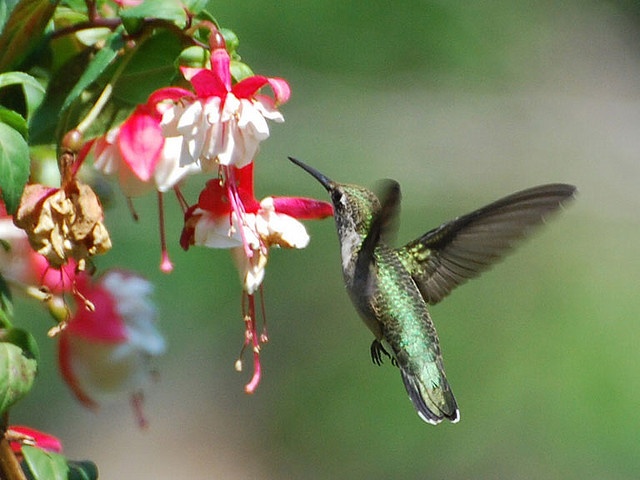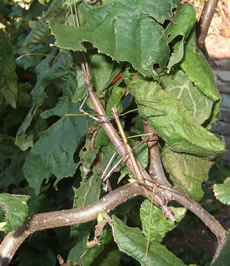 |
| Animal-plant Interactions |
The ways in which certain animals and plants interact have evolved in some cases to make them interdependent for nutrition, respiration, reproduction, or other aspects of survival.
Ecology represents the organized body of knowledge that deals with the relationships between living organisms and their nonliving environments. Increasingly, the realm of ecology involves a systematic analysis of plant-animal interactions through the considerations of nutrient flow in food chains and food webs, exchange of such important gases as oxygen and carbon dioxide between plants and animals, and strategies of mutual survival between plant and animal species through the processes of pollination and seed dispersal.
A major example of animal-plant interactions involve the continual processes of photosynthesis and cellular respiration. Green plants are classified as ecological producers, having the unique ability, by photosynthesis, to take carbon dioxide and incorporate it into organic molecules.
  |
Animals are classified as consumers, taking the products of photosynthesis and chemically breaking them down at the cellular level to produce energy for life activities. Carbon dioxide is a waste product of this process.
Mutualism
Mutualism is an ecological interaction in which two different species of organisms beneficially reside together in close association, usually revolving around nutritional needs.
One such example is a small aquatic flatworm that absorbs microscopic green algae into its tissues. The benefit to the animal is one of added food supply. The mutual adaptation is so complete that the flatworm does not actively feed as an adult.
The algae, in turn, receive adequate supplies of nitrogen and carbon dioxide and are literally transported throughout tidal flats in marine habitats as the flatworm migrates, thus exposing the algae to increased sunlight. This type of mutualism, which verges on parasitism, is called symbiosis.
Coevolution
Coevolution is an evolutionary process wherein two organisms interact so closely that they evolve together in response to shared or antagonistic selection pressure. A classic example of coevolution involves the yucca plant and a species of small, white moth (Tegitecula).
The female moth collects pollen grains from the stamen of one flower on the plant and transports these pollen loads to the pistil of another flower, thereby ensuring cross-pollination and fertilization. During this process, the moth will lay her own fertilized eggs in the flowers’ undeveloped seed pods.
The developing moth larvae have a secure residence for growth and a steady food supply. These larvae will rarely consume all the developing seeds; thus, both species (plant and animal) benefit.
Although this example represents a mutually positive relationship between plants and animals, other interactions are more antagonistic. Predator-prey relationships between plants and animals are common. Insects and larger herbivores consume large amounts of plant material. In response to this selection pressure, many plants have evolved secondary metabolites that make their tissues unpalatable, distasteful, or even poisonous. In response, herbivores have evolved ways to neutralize these plant defenses.
Mimicry and Nonsymbiotic Mutualism
 |
| Mimicry |
Certain types of insects, such as the leaf hopper, walking stick, praying mantis, and katydid (a type of grasshopper), often duplicate plant structures in environments ranging from tropical rain forests to northern coniferous forests. Mimicry of their plant hosts affords these insects protection from their own predators as well as camouflage that enables them to capture their own prey readily.
Certain species of ambush bugs and crab spiders have evolved coloration patterns that allow them to hide within flower heads of such common plants as goldenrod, enabling them to ambush the insects that visit these flowers.
In nonsymbiotic mutualism, plants and animals coevolve morphological structures and behavior patterns bywhich they benefit each other but without living physically together.
This type of mutualism can be demonstrated in the often unusual shapes, patterns, and colorations that more advanced flowering plants have developed to attract various insects, birds, andmammals for pollination and seed dispersal purposes. Accessory structures, called fruits, form around seeds and are usually tasty and brightly marked to attract animals for seed dispersal.
Although the fruits themselves become biological bribes for animals to consume, often the seeds within these fruits are not easily digested and thus pass through the animals’ digestive tracts unharmed, sometimes great distances from the parent plant. Some seeds must pass through the digestive plant of an animal to stimulate germination.
Other types of seed dispersal mechanisms involve the evolution of hooks, barbs, and sticky substances on seeds that enable them to be easily transported by animal fur, feet, feathers, or beaks. Such strategies of dispersal reduce competition be- tween the parent plant and its offspring.
Pollinators
 |
| Pollinators |
Because structural specialization increases the possibility that a flower’s pollenwill be transferred to a plant of the same species, many plants have evolved a vast array of scents, colors, and nutritional products to attract pollinators. Not only does pollen include the plant’s spermcells; it also represents a food reward.
Another source of animal nutrition is a substance called nectar, a sugar-rich fluid produced in specialized structures called nectaries within the flower or on adjacent stems and leaves.
Assorted waxes and oils are also produced by plants to ensure plant-animal interactions. As species of bees, flies, wasps, butterflies, and hawk-moths are attracted to flower heads for these nutritional rewards, they unwittingly become agents of pollination by transferring pollen from stamens to pistils.
Some flowers have evolved distinctive, unpleasant odors reminiscent of rotting flesh or feces, thereby attracting carrion beetles and flesh flies in search of places to reproduce and deposit their own fertilized eggs.
As these animals copulate, they often become agents of pollination for the plant itself. Some tropical plants, such as orchids, even mimic a female bee, wasp, or beetle, so that the insect’s male counterpart will attempt to mate with them, thereby encouraging precise pollination.
Among birds, hummingbirds are the best examples of plant pollinators. Various types of flowers with bright, red colors, tubular shapes, and strong, sweet odors have evolved in tropical and temperate regions to take advantage of hummingbirds’ long beaks and tongues as an aid to pollination.
Because most mammals, such as small rodents and bats, do not detect colors as well as bees and butterflies do, some flowers instead focus upon the production of strong, fermenting, or fruit-like odors and abundant pollen rich in protein. In certain environments, bats and mice that are primarily nocturnal have replaced day-flying insects and birds as pollinators.